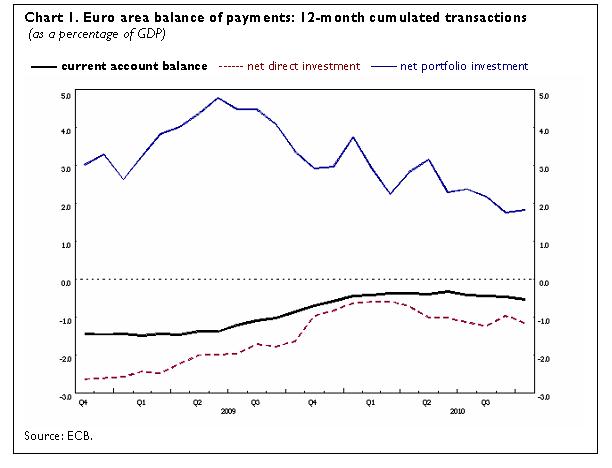Euro area balance of payments in October 2010
In October 2010 the seasonally adjusted current account of the euro area recorded a deficit of EUR 9.8 billion. In the financial account, combined direct and portfolio investment recorded net inflows of EUR 4 billion (non-seasonally adjusted).
Current account
The seasonally adjusted current account of the euro area recorded a deficit of EUR 9.8 billion in October 2010 (see Table 1). This reflected deficits in current transfers (EUR 7.3 billion), income (EUR 2.3 billion) and goods (EUR 1.9 billion), which were only partly offset by a surplus in services (EUR 1.7 billion).
The 12-month cumulated seasonally adjusted current account recorded a deficit of EUR 49.3 billion in October 2010 (around 0.5% of euro area GDP – see Table 1 and Chart 1), compared with a deficit of EUR 77.4 billion a year earlier. The reduction in the current account deficit was due predominantly to a decrease in the income deficit (from EUR 34.7 billion to EUR 14.4 billion) and an increase in the goods surplus (from EUR 20.6 billion to EUR 30.6 billion).

Financial account
In the financial account (see Table 2), combined direct and portfolio investment recorded net inflows of EUR 4 billion in October 2010, as a result of net inflows in portfolio investment (EUR 14 billion) that were partly offset by net outflows in direct investment (EUR 10 billion).
The net outflows in direct investment resulted predominately from net outflows in other capital (mostly inter-company loans) of EUR 10 billion. Net flows in equity capital and reinvested earnings were balanced, as these forms of direct investment in the euro area offset the corresponding forms of direct investment abroad. These net flows reflected mainly the restructuring of a large multinational group with its headquarters in the euro area, which involved an exchange of shares between the parent company and its foreign affiliates.
Portfolio investment recorded net inflows in equity (EUR 29 billion) that were partly offset by net outflows in debt instruments (EUR 15 billion). The net inflows in equity were mainly accounted for by net purchases of euro area equity securities by non-residents. The net outflows in debt instruments resulted from net purchases of foreign debt securities by euro area residents, reflecting, among other factors, the transfer of assets and liabilities from MFI subsidiaries abroad to a “bad bank” scheme set up within the general government sector of one euro area country.
The financial derivatives account recorded net outflows of EUR 8 billion.
Other investment recorded net inflows of EUR 5 billion, mainly reflecting net inflows in MFIs (excluding the Eurosystem) of EUR 24 billion and net outflows in general government (EUR 19 billion). These developments also reflected the transfer of assets and liabilities from MFI subsidiaries abroad to the euro area under the aforementioned “bad bank” scheme.
The Eurosystem’s stock of reserve assets increased from EUR 552 billion to EUR 556 billion in October 2010, mainly on account of valuation effects (transactions were close to balance).
In the 12-month period to October 2010, combined direct and portfolio investment recorded cumulated net inflows of EUR 62 billion, compared with net inflows of EUR 156 billion in the preceding 12-month period. This decrease was the result of lower net inflows in portfolio investment (down from EUR 302 billion to EUR 167 billion), which were only partly offset by lower net outflows in direct investment (down from EUR 146 billion to EUR 105 billion). The decrease in net inflows in portfolio investment was mainly due to lower net inflows in bonds and notes (down from EUR 197 billion to EUR 43 billion).
Data revisions
This press release incorporates revisions to the data for September 2010. These revisions have not significantly altered the figures previously published.
Additional information on the euro area balance of payments and international investment position
In this press release, the seasonally adjusted current account refers to working day and seasonally adjusted data. Data for the financial account are non-working day and non-seasonally adjusted.
In line with the agreed allocation of responsibilities, the European Central Bank compiles and disseminates monthly and quarterly balance of payments statistics for the euro area, whereas the European Commission (Eurostat; see “Euro-indicators” new releases) focuses on quarterly and annual aggregates for the European Union. These data comply with international standards, particularly those set out in the IMF’s Balance of Payments Manual (fifth edition). The aggregates for the euro area and the European Union are compiled consistently on the basis of transactions and positions with residents of countries outside the euro area and the European Union respectively.
A complete set of updated euro area balance of payments (including a quarterly geographical breakdown by main counterparts) and international investment position statistics is available in the “Statistics” section of the ECB’s website under the headings “Data services”/“Latest monetary, financial markets and balance of payments statistics”. These data, as well as historical euro area balance of payments time series, can be downloaded from the ECB’s Statistical Data Warehouse (SDW). Data up to October 2010 will also be published in the January 2011 issues of the ECB’s Monthly Bulletin and Statistics Pocket Book. Detailed methodological notes are available on the ECB’s website. The next press release on the euro area monthly balance of payments will be published on 19 January 2011, together with the quarterly international investment position.
Annexes
Table 1: Current account of the euro area
Table 2: Monthly balance of payments of the euro area
Europese Centrale Bank
Directoraat-generaal Communicatie
- Sonnemannstrasse 20
- 60314 Frankfurt am Main, Duitsland
- +49 69 1344 7455
- media@ecb.europa.eu
Reproductie is alleen toegestaan met bronvermelding.
Contactpersonen voor de media

